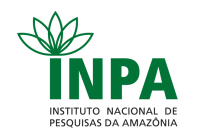Corpo Discente - Egressos
Renata Freitag
| Título | SENSIBILIDADE DOS ECOSSISTEMAS DA TRANSIÇÃO AMAZÔNIA-CERRADO ÀS MUDANÇAS AMBIENTAIS: EFEITOS DA SAZONALIDADE CLIMÁTICA NA DINÂMICA DE BIOMASSA E EFLUXO DE CO2 | ||||||||||||||||||||||||
| Data da Defesa | 14/09/2018 | ||||||||||||||||||||||||
| Download | Em sigilo | ||||||||||||||||||||||||
Banca
| |||||||||||||||||||||||||
| Palavras-Chaves | Carbono. Dinâmica de gás carbônico. Mudanças climáticas. Transição Amazônia-Cerrado. | ||||||||||||||||||||||||
| Resumo | Os ecossistemas tropicais são importantes no ciclo global do carbono, pois emitem e absorvem o CO2 atmosférico. Porém, as mudanças climáticas podem alterar essa capacidade desses ecossistemas em estocar carbono. Assim, conhecer e entender os processos da dinâmica do carbono são essenciais diante das atuais e futuras mudanças climáticas. Nossa pesquisa buscou avaliar a dinâmica e o comportamento funcional do ecossistema em função do efluxo de CO2 acima e abaixo da superfície do solo em um cerrado típico e um cerradão ao leste do estado de Mato Grosso, uma região de tensão ecológica entre a Amazônia e o Cerrado. Desenvolvemos nas duas fisionomias estudos de monitoramento intensivo da ciclagem do carbono, com a metodologia proposta pela rede de pesquisas de Monitoramento Global dos Ecossistemas (GEM) da universidade de Oxford. Realizamos as coletas entre agosto de 2014 a junho de 2017. A ocorrência de um evento El Niño em 2015/2016 ocasionou redução de aproximadamente 50% das chuvas. Constatamos que a hiperdinâmica da produtividade primária líquida (PPL) pode ser a principal fonte dos grandes estoques de carbono registrados para os dois ecossistemas da transição Amazônia/Cerrado. A PPL total do cerradão foi 33% maior que a do cerrado típico e o investimento na PPL aérea foi maior do que a subterrânea nas duas áreas. O cerrado investiu aproximadamente o dobro em PPL subterrânea (41,72% do total) quando comparado com o cerradão (21,44%). Por outro lado, o cerradão estocou mais carbono em troncos em relação ao cerrado típico (CT), que estoca 28% mais de carbono nas raízes do que o cerradão (CD). Os valores de PPLtotal reportados para as áreas de estudo se aproximam daqueles encontrados em outras florestas da Amazônia, as quais apresentam biomassa cerca de três vezes maior. Revelando uma hiperdinâmica da PPL nas áreas aqui estudadas o que pode acelerar a formação dos estoques de carbono na vegetação, provavelmente no solo. O índice de área foliar revelou efeito significativo e evidente de estresse ambiental apenas no cerradão, uma vez que a mortalidade arbórea neste ecossistema aumentou drasticamente no ano subsequente ao El Niño. A queda no índice de área foliar no CD não foi maior devido à compensação da abertura do dossel pelo crescimento de copa das árvores remanescentes. O CT apresentou maior resistência aos estressores ambientais, conforme o esperado, visto tratar-se de uma vegetação savânica, evolutivamente mais adaptada à seca e extremos de temperatura. Averiguamos que durante o El Niño as formações florestais investiram mais em raízes finas do que as savânicas. As duas vegetações são dependentes da sazonalidade climática, sendo a disponibilidade de água um fator limitante para o crescimento das raízes. Ou seja, X quanto menor a disponibilidade de água e dias sem chuva, menor é o investimento em raízes finas nas duas vegetações. Verificamos ainda que a seca severa e prolongada do El Niño de 2015/2016 ocasionou forte redução das emissões de CO2 do solo e alterações na dinâmica do sistema radicular fino e nas emissões de gás carbônico nas vegetações savânicas e florestais da transição. Inferimos que tais resultados podem gerar grandes efeitos negativos nos ecossistemas em longo prazo, especialmente por se tratar de vegetações hiperdinâmicas. Considerando as recentes mudanças climáticas, associadas às vegetações hiperdinâmicas da ZTE, fica evidente a vulnerabilidade destes ecossistemas às mudanças climáticas. Acreditamos que as oscilações no clima, como as observadas durante o último evento do El Niño (2015/2016), podem alterar e/ou realocar as concentrações de carbono armazenado nos diversos compartimentos do ecossistema. Considerando que o aumento da temperatura, o desmatamento e as queimadas tendem a tornar-se mais intensos, logo podemos esperar que as alterações no clima ocasionem mudanças no padrão de distribuição das chuvas e, consequentemente, redefinição dos ecossistemas em sua configuração atual, podendo ocorrer colapso nos estoques de carbono. Portanto, entendemos que nossa pesquisa contribuiu para melhor entender os mecanismos de ação e reação que governam as vegetações florestais e savânicas da transição Amazônia/Cerrado quando submetidas ao estresse hídrico. Contudo, apesar da consistência dos dados, ainda devemos ter certa cautela na interpretação dos resultados referentes a resistência ou resiliência dos ecossistemas da transição Amazônia/Cerrado aos estressores ambientais. Isto se deve ao fato de que somente resultados de longo prazo, preferencialmente de no mínimo uma década, podem trazer respostas definitivas acerca de mudanças climáticas e seus efeitos na vegetação nativa. | ||||||||||||||||||||||||
| Abstract | Tropical ecosystems are important in the global carbon cycle because they emit and absorb atmospheric CO2. However, climate change can alter this ability of these ecosystems to store carbon. Thus, knowing and understanding carbon dynamics processes are essential in the face of current and future climate change. Our research aimed to evaluate the dynamics and functional behavior of the ecosystem due to the efflux of CO2 above and below the soil surface in a typical cerrado and a cerrado in the state of Mato Grosso, a region of ecological tension between the Amazon and Thick. In the two physiognomies, intensive carbon cycling monitoring studies were carried out using the methodology proposed by the University of Oxford Global Monitoring for Ecosystems (GEM). We conducted the collections between August 2014 and June 2017. The occurrence of an El Niño event in 2015/2016 caused a reduction of approximately 50% of the rainfall. We verified that the hyperdynamic of the net primary productivity (NPP) may be the main source of the large carbon stocks recorded for the two ecosystems of the Amazon/Cerrado transition. The total NPP of the cerradão was 33% larger than that of the typical cerrado and the investment in the aerial PPL was larger than the underground in the two areas. The cerrado invested approximately double the NPP underground (41.72% of the total) when compared to the cerradão (21.44%). On the other hand, cerradão stored more carbon in logs than the typical cerrado (TC), which stores 28% more carbon in roots than cerradão (CD). The PPLtotal values reported for the study areas approximate those found in other Amazonian forests, which have biomass about three times higher. Revealing a hyperdynamics of NPP in the areas studied here, which can accelerate the formation of carbon stocks in the vegetation, probably in the soil. The leaf area index revealed a significant and evident effect of environmental stress only on the cerradão, since tree mortality in this ecosystem increased drastically in the year following El Niño. The leaf area index decrease in the CD was not higher due to the offset of the canopy opening by the canopy growth of the remaining trees. The TC showed greater resistance to the environmental stressors, as expected, since it is a savanna vegetation, evolutionarily more adapted to drought and temperature extremes. We found that during El Niño forest formations invested more in thin roots than savannas. The two vegetations are dependent on climatic seasonality, and water availability is a limiting factor for root growth. That is, the lower the availability of water and days without rain, the smaller the investment in fine roots in the two vegetations. We also verified that the severe and prolonged drought of the El Niño of 2015/2016 caused a strong reduction of the CO2 emissions of the soil and changes in XII the dynamics of the fine root system and carbon dioxide emissions in the savanna and forest vegetation of the transition. We infer that such results can generate large negative effects on the ecosystems in the long term, especially since they are hyperdynamic vegetations. Considering the recent climatic changes associated with the hyperdynamic vegetation of the ZTE, the vulnerability of these ecosystems to climate change is evident. We believe that the oscillations in the climate, such as those observed during the last El Niño event (2015/2016), can alter and/or reallocate the concentrations of carbon stored in the various compartments of the ecosystem. Considering that the increase in temperature, deforestation and fires tend to become more intense, we can expect that changes in the climate will cause changes in the pattern of rainfall distribution and, consequently, the redefinition of ecosystems in their current configuration. collapse in carbon stocks. Therefore, we understand that our research contributed to better understand the mechanisms of action and reaction that govern the forest and savanna vegetation of the Amazon/Cerrado transition when subjected to water stress. However, despite the consistency of the data, we must still be cautious in interpreting the results regarding the resistance or resilience of the ecosystems of the Amazon/Cerrado transition to the environmental stressors. This is due to the fact that only long-term results, preferably at least a decade, can provide definitive answers about climate change and its effects on native vegetation. | ||||||||||||||||||||||||
Parceiros

























